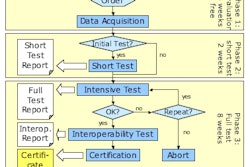SAN ANTONIO - With comprehensive planning, PACS users can maintain a similar level of radiology report turnaround time during scheduled downtime and also improve radiology performance during periods of unscheduled downtime, according to Dr. Steven Horii of the University of Pennsylvania Medical Center in Philadelphia.
"Planning involves technical, professional, and administrative aspects, all of which are important," Horii said. He spoke at this week's PACS 2007 conference, sponsored by the University of Rochester School of Medicine & Dentistry in New York.
In today's digital world, digital healthcare information and management system (DHIMS) and PACS networks have become a critical aspect of clinical operations. If the PACS goes down, facilities can often no longer fall back to film, Horii said. And even for those who can print film, their printing capacity is far reduced and the staff infrastructure for handling film likely no longer exists, he said.
Those who do employ a backup PACS network may not have deep archive access, and may have to redirect image input streams and set interfaces to other systems, Horii said.
Today, medical imaging is used by all clinical specialties. "Surgery, intensive care, and emergency medicine often have critical needs for imaging; if images are not available, some activities either stop or hold," he said.
A fault-tolerant PACS design can help avoid unscheduled downtime, as can searching for single points of failure during the planning process, Horii said. If a backup PACS is being used, a transition plan should be developed.
"Because there's nothing worse than having a backup system (if) nobody knows how to invoke it," he said.
Backup PACS
Thin-client Web distribution systems can function as a backup for a thick-client PACS network, since they tend to employ separate servers and storage, as well as switchable interfaces, Horii said.
If this approach is used, customers should ensure that the thin-client can be run on the main PACS workstations, or that monitors with necessary quality be in place on some thin-client computers, he said.
Add-on processing systems might also be suitable as a backup PACS. For example, some 3D visualization systems have a thin-client application that can be used in a pinch for primary reading, Horii said. These systems also often have separate servers and storage.
It's important to know how images get to a backup PACS. If images first go through the main PACS network, institutions might not have a backup at all if the main system goes down, Horii said.
"Consider image routers that can send images to multiple destinations," he said. "Instead of (having images) go into the main PACS and then out to other systems, go to a router, and it knows where to send images."
A backup PACS may not have worklist server or dictation system interfaces, Horii said. So some manual or paper-based information tracking may have to be used.
Policies and procedures should be developed to handle downtime, including well-defined decision criteria for when to switch to backup operations, he said.
"If the system is only going to be down for a couple minutes, you may be better off waiting it out because the time it takes you to change to the backup strategy may take longer than the downtime," Horii said. "Changing personnel procedures and tasks itself takes time. If at all possible, you need an estimate of downtime from the vendor or your own PACS administrator."
Impact on turnaround time
Researchers at the University of Pennsylvania Medical Center studied the impact of scheduled downtime, and found a significant negative impact on report turnaround time. Even worse turnaround time, though, was found during a nonscheduled downtime period, Horii said.
The declines were due to factors such as reduced automatic information flow, with different procedures in effect, longer time to start and complete exams, and longer time before notification that an exam was ready to be interpreted, he said.
Radiologists were also not as facile using different workstations, according to Horii. Problems included no worklists, a different user interface, some monitors not suitable for all studies, and fewer available workstations.
With the alternate information flow, interpreting studies got pushed into the time when attending radiologists were no longer present, Horii said. A large backlog of resident-interpreted studies had to be reviewed the next day.
A new plan
Facing another scheduled downtime longer than the scheduled downtime period it had studied, the institution proposed a plan that encompassed technical, communications, and administrative factors.
An independent Web-based viewer with its own server and interfaces in development with another vendor was selected to serve as a backup diagnostic reading application. In addition, existing review workstations in the department were used to route studies, allowing only minor changes to be made in the normal imaging equipment setup during the backup plan, Horii said.
The Web viewer was tested on the main PACS workstations, following permission from the PACS vendor to run it. While the user interface was different with the Web viewer, radiologists could utilize the same monitors as they usually used, allowing for more workstations to be available, according to Horii.
As for communications, a single point of contact was designated for referring physicians and house staff. Hospital sections that had gone paperless would have to go back to paper requests. The department also began distributing updates and information to staff well before the downtime date, Horii said.
Links were provided on the departmental Web site, designating downtime procedures to be followed, instructions for using workstations, and descriptions of proposed workflow. A plan was also developed for increased staffing, and discussion took place regarding the potential costs of the increased staffing, according to Horii.
The downtime was scheduled with the vendor to take place over a weekend, beginning on a Saturday afternoon. Normal operation was expected to return Sunday morning, he said.
By increasing staffing, the institution sought to minimize the number of unread studies prior to the start of the downtime, make up for anticipated slower workflow, and reduce individual workload during the postdowntime recovery, Horii said. The additional staff included one additional attending radiologist for body CT/ultrasound, two additional attendings in chest/musculoskeletal, and four fourth-year residents, each of whom covered a six-hour shift.
After the downtime was over, the institution compared average report turnaround times for three uptime periods, one unplanned downtime period, previous scheduled downtime, and the planned downtime period. All periods had around the same number of studies.
The first three periods of uptime had average report turnaround times of 2.48 hours, 2.55 hours, and 2.66 hours, respectively, compared with 6.49 hours for the unplanned downtime period, 3.21 hours for the scheduled downtime, and 2.29 hours for the planned downtime.
The previously scheduled downtime and the unplanned downtime turnaround times were significantly worse than the uptime periods, while the planned downtime turnaround time was significantly better than the previous scheduled downtime and the uptime periods, Horii said.
Worth the cost?
It may be difficult to decide if the added expense of extra staffing for planned downtime is worth it, as it's hard to place a value on reduced turnaround time, he said. The major cost of the planning process was the added labor cost, with three part-time FTE attendings each covering one additional weekend day, and the four part-time FTE residents each covering one six-hour shift, Horii said.
Report turnaround time was actually better than during typical uptime periods, which might lead administration to conclude that more people were there than were needed, he said.
The department did receive compliments, however, from referring physicians and house staff who had been used to a considerable drop in radiology performance during PACS downtime, Horii said. And the Monday backlog was no worse than usual after a weekend, he said.
Comprehensive planning for scheduled downtime can keep radiology performance on a similar level to normal operation, Horii concluded.
"Frequent communication with staff, referring physicians, house staff, and vendor personnel was also very important well before the downtime began," he said.
By Erik L. Ridley
AuntMinnie.com staff writer
March 22, 2007
Related Reading
Part XIV: Exploring PACS Secrets -- Reading the fine print, March 12, 2007
IT vendors, healthcare facilities scramble to remedy early switch to DST, March 8, 2007
Part XIII: Exploring PACS Secrets -- Penny-wise, pound-foolish, October 16, 2006
Defining PACS policy and procedures, April 19, 2006
Enterprise archive yields care, efficiency gains, April 10, 2006
Copyright © 2007 AuntMinnie.com



















